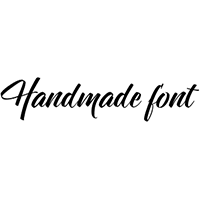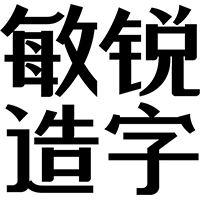Colvert, Achieving Harmony Through Diversity

Earlier this year the French TDC2, Letter.2, Granshan) and were exhibited in a dozen countries.
Recently typographies.fr released the remarkable multi-lingual typeface Our Favourite Typefaces of 2012.

Four designers developing four different scripts for one single type family seems like a complex undertaking. How did the project take off?
Jonathan Perez | "The project started with me drawing the Latin version. I wanted to have a visual basis before contacting other type designers, presenting them the project and convincing them to participate. The basic idea was to create four scripts that would be as differentiated as possible yet have a harmonious relationship with each other. Choosing with which script to start wasn't that important – it could have been any other system, or any combination of multiple systems. The only constraint I imposed onto the other designers was that all four scripts would share an identical optical size at a given point size. After this, everyone worked from this starting point: create something both harmonious yet differentiated."

Jonathan studied typography for four years at the École Estienne in Paris. Before founding typographies.fr in 2008 he interned at the association for Latin calligraphy Ductus and spent six months at the French Institute for Oriental Archaeology (IFAO) in Cairo, Egypt.
Jonathan Perez | "I specifically looked for native users of the writing system they needed to develop. I already knew the work of Natalia and Kristyan well, so I quickly decided I wanted to work with them for Cyrillic and Arabic. While I was searching for a Greek type designer Irene was recommended to me, and discovering her work convinced me she was the right match."

Natalia Chuvatin studied graphic design and typography at the Moscow State University of Printing Arts. Visiting École Estienne when she moved to Paris made a huge impression on her.
Natalia Chuvatin | "I was blown away by the work hanging on display and decided that this was the school I wanted to attend, to deepen my knowledge of typography and gain experience. I was fortunate to study under some fantastic teachers. Our core trio of professors – Franck Jalleau (typography), Michel Derre (calligraphy) and Margaret Gray (graphic design) – greatly contributed to shaping my vision as a typographer. Since graduating I have been working as a freelance typographer and graphic designer, completing projects for French and Russian clients."
"Jonathan Perez also graduated from the faculty of Typography at École Estienne and it is through contacts at the school that we came to work together on the Colvert project. I am passionate about the Cyrillic script, and it was a joy to be able to share that passion through collaboration on Colvert. Besides, I know he has very high standards in his work – the excellent execution of Colvert Latin is proof of this."

After graduating with a BA in Graphic Design, Kristyan Sarkis joined Al Mohtaraf Beirut, a studio with rich traditions in Arabic type and letter forms. On an uneventful afternoon design director Yara Khoury entrusted him with the task of drawing an Arabic counterpart for a Latin corporate typeface.
Kristyan Sarkis | "I quickly fell in love with the process and the universe of Arabic letter forms, and Yara encouraged me to pursue type design. In 2010 I did type]media at KABK which definitely opened my eyes to the world of type. Since then, I have almost strictly been working on Arabic type design projects: Colvert Arabic for Typographies.fr, an ongoing collaboration with Typotheque (Thuraya, Greta Arabic, Greta Sans Arabic type system), as well an exciting customized Arabic typeface in the making."
"I only knew about Jonathan through the releases from Typographies.fr which I found very interesting. Jonathan contacted me after he saw Thuraya among the winners of TDC2 2011. He congratulated me and mentioned in passing he had an idea for 'strange project'. When he later explained the concept behind Colvert I was immediately on board."

Typography was something Irene Vlachou enjoyed since her BA studies in graphic design in Athens, Greece. The logical next step was to enrol in the MA Typeface Design at the University of Reading.
Irene Vlachou | "After my visit to Reading I was imbued with the complexity of typeface design, its history and mechanics, and this convinced me to take it a step further. The teachings and guidance from Gerry Leonidas made me pursue a career in type design, specialising in the Greek script."
"Although the Colvert project marks my first collaboration with Jonathan, I was familiar with his work on the Coptic script and his success at the TDC2 competition. I was curious at first, and after I saw the Latin design I realised it would be a wonderful opportunity to create a traditional Greek typeface with a modern flair."

How did the three sister designs evolve, and how did you interact with Kristyan, Natalia and Irene during their development?
Jonathan Perez | "I initiated the project but didn't want to steer the other designers; I wanted us all to be equal in the development of Colvert. This was in the interest of the project – I wished for the resulting multi-lingual, multi-script type family to be as varied and surprising as the type designers were different. I intervened personally, enquiring with each of them about the choices they made for their design, trying to understand their point of view, pushing the experimentation even further. I intervened collectively, to allow each one of them to keep track of the other designers' progress, distributing images and sharing specific ideas I found interesting. To draw a parallel with the world of music, I see ourselves as four musicians who improvised together on a musical theme fixed by one of them – this implies a lot of freedom, but also a lot of effort, listening to the others and building upon their improvisations."

Similarities between the Latin (top), Greek (middle) and Cyrillic (bottom) capitals of Colvert.
To the uninitiated the Cyrillic and Greek alphabets look structurally similar the Latin alphabet. What are the most important differences?
Natalia Chuvatin | "When comparing Latin and Cyrillic letters we see that some look the same or are quite similar in both alphabets, while others simply are built according to the same principles. This is because the Cyrillic script, like Latin, has descended from Greek (the Cyrillic alphabet was adapted from Greek in the 9th century by two Byzantine Greek brothers born in Thessalonica – Cyril and Methodius). This structural similarity is especially notable in the capitals, yet we see striking differences in the lowercase letters. The Latin lowercase clearly shows its calligraphic origin, with dominating verticals and curves ('garlands' and 'arches'). In Cyrillic however the verticals and horizontals dominate, because most lowercase letters repeat their capital forms: only 7 of the 33 have their own structure. This causes an abundance of double-sided serifs. The Cyrillic script also has fewer letters with ascenders and descenders than the Latin – also only 7 out of 33, compared to 12 in Latin. These and some other peculiarities result in Cyrillic text having a somewhat monotonous and static impression in comparison to Latin."

Cyrillic alphabet, with (top) capitals whose character shapes are not repeated in the lowercase, and (bottom) lowercase letters with ascenders and descenders.

Comparison between the Latin (top) and Greek (bottom) lowercase.
Irene Vlachou | "Just like with Cyrillic, the similarities between the Greek and Latin alphabets are primarily apparent in the capitals. Nonetheless the lowercase is entirely different – it has its own specific rhythm, a much more curvier structure and sometimes even an axis that is exactly the opposite of the Latin. This is why it should be approached differently from the Latin, not just for the sake of authenticity but because it is fundamentally different. Like any script it has its own identity and use. The type designer should always keep that in mind when drawing common letters that can be confused between the Latin and the Greek. Letters that commonly cause confusion are the lowercase Latin 'v' and the Greek 'nu', or the lowercase Latin 'o' and the Greek 'omicron'. Yet there are also letters where the designer can go either way – for example one can draw the capital Greek 'Upsilon' exactly like its Latin counterpart 'Y', or differentiate them like I did for Colvert."

Examples of glyphs that could be mistaken as identical with, or a mirror image of their Latin counterparts in Greek (top) and Cyrillic (bottom).
Natalia Chuvatin | "The Latin and Cyrillic alphabets have a certain number of basic letterforms in common. Some of them even represent the same phoneme, while others do not (for instance, the Cyrillic 'y' sounds like 'oo', as in oodles). There are a number of Cyrillic signs that at first glance look similar to Latin, but should never be copied from their Latin counterparts. The letter 'K' is a typical example. The Latin 'K' has two straight diagonals, while its Cyrillic sister 'Ka' will most likely have two curved branches. In the case of serif typefaces the upper branch will end up in a teardrop or ball terminal. Also, the letter 'Ya' must not be designed as a mirror reflection of the Latin 'R' – it should have a leg shaped closely to that of the 'K'. Another example is the Cyrillic breve which usually differs in shape from the Latin one."

Visual similarities between Colvert Arabic and Colvert Latin.
The Arabic script is by nature very different from the Latin alphabet. How were visual connections made between the two designs?
Kristyan Sarkis | "The visual connections came as a consequence of the ideological link and to the non-limiting nature of the brief. I tried to extract the essence of Colvert Latin, understand its relationship with the writing system in terms of structure, proportions and aesthetic details, and then create an equivalent relationship between Colvert Arabic and the Arabic script. When I initially started drawing Colvert Arabic I was mainly concerned with the colour and optical size. The letter forms developed independently from the Latin counterpart. Once the structure was built, I looked for ways to enhance the optical continuity between these two very different writing systems: the softness of the curvatures, the amount and shift of contrast, the calligraphic details, etc."
And how are the Cyrillic and Greek related to the Latin?
Natalia Chuvatin | "The 'torso' or x-height was the only parameter that Jonathan asked us to respect. On the one hand the optical continuity created itself since the Latin and Cyrillic alphabet are so closely related. On the other hand creating a classic 'cyrillised' version was out of the question as well since this was not the goal of our experiment. So the challenge was to find the golden mean, the starting point from where I could alter elements from the Latin version. All those changes had to be justified. One of the main criteria for me was improving the legibility of the Cyrillic text. I tried to avoid emphasising the 'vertical-horizontal' pattern by opening up the character shapes, emphasising the curves wherever possible, etc. Also, since serifs are far more prominent in the Cyrillic lowercase I shortened and lightened them."

Different approach for letters in Colvert Regular and Italic that traditionally have the same structure in Latin (left) and Cyrillic (right), but represent different phonemes.
"Preserving and exploiting the typographic traditions of the Cyrillic script was my second guiding rule. It was like doing a translation, for example how to graphically interpret those letters that traditionally have the same structure in Latin and Cyrillic. My solution for this challenge was paying attention to phonetics. If two letters represented the same phoneme, they were allowed to keep the same form, while letters that represent different sounds had to be approached differently. An exception was made for 'H' and 'B' which are too basic in their structure."
Irene Vlachou | "I decided to give the Greek a traditional structure, with a skeleton that had a different axis from the Latin. Still in a situation like this there are a number of aspects that you can keep the same across the two scripts. Terminal forms can have the same structure, transitions between thin and thick can be kept identical, and in general you need to have the same text colour in the Latin and the Greek. You achieve this through a lot of testing."

Sketches for Colvert Cyrillic Regular.

Sketches for Colvert Cyrillic Italic.
Did you have to experiment a lot, or did the final forms present themselves rather quickly?
Natalia Chuvatin | "I experimented mostly with details or deciding which form to use for particular glyphs. For this I went 'back to basics': sketching on paper. For the rest I worked directly in the computer. Also, proper attention needed to be paid to some signs from non-Russian alphabets as Colvert Cyrillic supports no less than 40 languages. I derived great pleasure from designing Colvert Italic where I had fun creating dynamic letter forms to somehow counterpoise the static appearance of the roman."
Irene Vlachou | "My experiments were focussed on getting the details in the design right, not the actual skeleton of the glyphs. The idea of the whole project was to create a traditional text face with a modern flair that would respect the unique identity of its each script. What I had to do was to study the forms that would give a Greek identity to this typeface while keeping in mind that it was meant for contemporary use."

Pencil sketches for Colvert Arabic.
Kristyan Sarkis | "It was clear from the start that Colvert Arabic had to be a Naskh typeface – the most suitable style for running text – due to the character of Colvert Latin and the main intended usage for the family: book setting. My journey with Naskh had already started with Greta Arabic, which allowed me to experiment a lot with Naskh letterforms from a contemporary perspective. I based myself on this knowledge and furthered my research through a sort of meditation into the calligraphic style. Therefore building the structure of Colvert Arabic's basic letterforms was a smooth and natural progression. The more complicated experiments had to do with extended alternates, swashes, inverted swashes, ligatures of two and three glyphs, which were studied and grouped according to similarities in the function or the level of complexity of the forms. It was crucial that these elaborate forms blend just as well as the basic ones in words, short paragraphs or long running text."

Annotated calligraphic sketches for Colvert Arabic.
Did the three other versions in any way influence the original Latin design for Colvert?
Jonathan Perez | "The Latin version of Colvert evolved very little: it was the task of the other three designers to find the proper visual distance in relation to this reference point, steering clear as much as possible without severing the connection. This working method requires a static benchmark serving as a visual anchor for the other designers. Simply put, it all boiled down to creating enough distance as opposed to getting as close as possible."
How did your design evolve, and how did Jonathan interact with you during its development?
Natalia Chuvatin | "From the very beginning all three of us enjoyed Jonathan's complete trust for creating our Colvert versions. He kept a close watch on the development, encouraging experiments especially in the initial stages of the project when the main strategic decisions had to be taken. The first version of the Cyrillic variant seemed too 'well-behaved' to him, too close to its Latin counterpart. This spurred me on to further research what was, as a matter of fact, striking the perfect balance between what should be changed – in relation to the Latin version – and what should be preserved: 'to change or not to change'."
Irene Vlachou | "Jonathan respected our way of designing and left us free reign. I did my research and a number of sketches, mainly on terminals. As soon as I had the first draft ready of the regular weight I sent it to Jonathan for some feedback. We had some discussions about the actual colour of the Greek and what alterations we should do, but after that we only exchanged ideas about testing and post-production."

Annotated print proofs for Colvert Arabic.
Kristyan Sarkis | "Two aspects were essential in the process of designing Colvert Arabic. Through its authenticity to the Naskh calligraphic style, I got to learn a lot more about the movement of the hand and the harmonious flow and distribution of black, naturally created by the calligraphic pen used at a certain angle. The other aspect was the evolution from a simple text typeface to a complex system of calligraphic layers that stemmed from a wealth of letter forms mostly forgotten in modern Arabic typefaces. Colvert Arabic's rich character set puts new typographic tools in the hands of designers, typographers, typesetters. Jonathan was very trusting throughout the whole process, and always encouraging and appreciative, especially when it started to get increasingly complex. It was a very smooth collaboration."
Header image:Mallard © Richard Lloyd


































 闽公网安备35010202000240号
闽公网安备35010202000240号